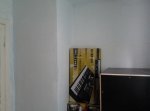Hello guys.
Not long ago I've started to build a studio room. Made 2 DIY panels, put them to the left and to the right. A thick rug is on the back wall. Thought the sound will be awesome, because I have to do mixing and it's really important! But the problem lies solely in low frequency range.
The room is pretty empty, I mean no furniture at all. Can this be an issue?
Will panels in the corners and on the ceiling save me?
Or the wall from my back can cause some problems?

This is how my room frame looks like)) I'm not a paint master actually))
And English is not my native language, so sorry If I made some mistakes.
All kind of advices would be much appreciated!
Not long ago I've started to build a studio room. Made 2 DIY panels, put them to the left and to the right. A thick rug is on the back wall. Thought the sound will be awesome, because I have to do mixing and it's really important! But the problem lies solely in low frequency range.
The room is pretty empty, I mean no furniture at all. Can this be an issue?
Will panels in the corners and on the ceiling save me?
Or the wall from my back can cause some problems?

This is how my room frame looks like)) I'm not a paint master actually))
And English is not my native language, so sorry If I made some mistakes.
All kind of advices would be much appreciated!


